November 29, 2021

Pakistan, India, and Yemen top the list of countries at risk for new mass killing in 2021 or 2022, according to the Early Warning Project’s latest annual Statistical Risk Assessment. The new report also highlights countries that have been rated consistently high-risk over multiple years (Afghanistan, the Democratic Republic of Congo, Ethiopia, and Somalia), and countries where estimated risk has increased significantly since last year’s assessment (Guinea, Thailand, and Chad). Each of these countries merits additional attention, analysis, and action to help prevent mass atrocities, according to the report.
What is the Early Warning Project?
The Early Warning Project’s annual Statistical Risk Assessment was created by the Museum’s Simon-Skjodt Center and Dartmouth College’s Dickey Center for International Understanding to identify countries at risk for mass killing, raise warning signs, and encourage policy makers to take action to prevent mass atrocities.
Based on publicly available data, researchers built a model that asks, in effect, which countries today look most like countries that have experienced mass killing in the past, in the two years before the violence began? This annual report is the cornerstone of the Early Warning Project, which was founded in 2014.
What did we find?

The Early Warning Project considers the top-30 countries to be high-risk. In the new assessment, nearly half of these countries are already experiencing a mass killing. Consistent with other research, most high-risk countries have a history of mass killing and are currently experiencing an armed conflict.
At the same time, the composition of the high-risk group underscores that serious mass killing risks are not limited to a single region of the world or to highly authoritarian contexts. While 17 of the top-30 are in sub-Saharan Africa, 3 of the top-4 are in South Asia, and another 4 of the top-15 are in the Middle East or North Africa. Democracies, such as India and Indonesia, are represented in the high-risk group together with autocracies, such as Syria and China.
For more information on the risk factors and risk levels associated with any of the 160-plus countries included in this year’s assessment, visit the country pages on the Early Warning Project’s website.
What should I do with this information?
Early warning is a crucial element of effective atrocity prevention. Mass atrocities are always preceded by a range of early warning signs. If these signs are detected, their causes can be addressed, preventing the potential for catastrophic progression. This tool should enable policy makers, civil society, and other analysts to focus attention and resources on countries at highest risk, especially those not currently receiving sufficient attention.
Serving as a starting point for discussion and additional analysis about where preventive action is most needed, this report highlights key questions for policy makers and other users:
- Are threats of mass atrocities in high-risk countries receiving enough attention?
- What events or changes explain big shifts in estimated risk from last year’s assessment?
- What accounts for any discrepancies between the statistical results and experts’ expectations?
By combining global risk assessments with in-depth country analysis and preventive policy planning, we have the best chance of preventing future mass atrocities.
Learn more about how to use the Statistical Risk Assessment results, how the assessments are generated, and our interactive tool that allows users to change risk factor inputs and see how those changes would shift the risk for that country.
View All Blog Posts